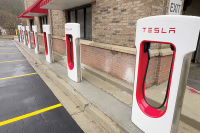Small is not only beautiful, but necessary
There are books that get your attention, and then there are books that GRAB your attention. The new book by Bill McKibben (author of The End of Nature and founder of the 350 Movement) is of the latter variety. Not only does it grab your attention, but it keeps it there. It takes possession of all your faculties from the first paragraph: “Imagine we live on a planet. Not our cozy, taken-for-granted earth, but a planet, a real one, with melting poles and dying forests and a heaving, corrosive sea, raked by winds, strafed by storms, scorched by heat. An inhospitable place.” To the last: “Eaarth represents the deepest of human failures. But we still must live on the world we’ve created — lightly, carefully, gracefully.” And even then, the contents linger, like the moisture of a heavy dew on a late spring morning.
Part naturalist and part science geek, McKibben’s book The End of Nature, published in 1990, was one of the first on the subject of global warming and was a warning for what might be in store for the planet. Now he is back, looking in hindsight and with scientific evidence to verify his former predictions and to confront us all with the implications for life on this planet for the indefinite future.
Eaarth, McKibben’s new name for the old planet Earth, is comprised of four chapters. The first two chapters delineate the problems we have created for ourselves as a result of our negligence in protecting our environment and in our mad rush towards progress at the hands of unregulated free-trade capitalism. The final two chapters outline and address ideas and methods that might see us through this myopic tunnel we’ve created for ourselves.
The first half of the book is staggering in its onslaught of facts and figures and substantiated scenarios, all of which are too real to be deflated with any sort of self-protective denial. Yet, McKibben’s writing style is casual, friendly, and even soothing, so as to allow the almost overwhelming deluge of damning information to mix gradually into one’s consciousness and become (un)comfortably part of one’s own personal organic perspective.
The whole of the book Eaarth revolves around the number and metaphor 350. 350 being the number of parts-per-million of carbon that can sustain, barely, life as we know it. In the first chapter, McKibben reminds us again and again that we have exceeded that plateau by a fairly large margin and are still moving in a destructive direction that may lead toward possible extinction.
He takes serious issue with the ideals of free-trade capitalism, free (meaning unchecked) enterprise and big corporate conglomerates. He is emphatic that bigger is not better. He cites extreme weather, rambling spills and deluges, crops withered and washed away. In parallel and for satirical effect, in chapter four he references herbicides with telltale names like Warrior, Extreme, Prowl and genetically engineered grain crops named Reactor, HeatShield, RayFighter. He points an accusatory finger at Big Oil and Big Coal, saying that the days of cheap gas, cheap energy and cheap food are over, and that we better be prepared to hunker down and start conserving all of the above — which will be considered almost luxury items and will be harder to come by on the new planet Eaarth.
In chapter two McKibben gets into the areas of growth, overpopulation and sea rise. He says that in the last century growth and expansion were the prevalent ideological model for almost everyone. Now, he says, we have expanded to maximum capacity of what the planet can carry and so our mindsets must change. He says that in the overpopulated world we now live in we must start thinking about conserving rather than compiling.
He is certain that bailouts, such as the one recently instituted by the Obama administration to counter the economic crisis, are not going to fix our future problems.
Rather, “I think the system has met its match. It is going to take a concerted effort to change our perspective, our habits, and our goals for living on our new Eaarth.” He gives specific examples as to where we are over-indulging and what we can do to cut back.
After a hundred pages of “bad news,” McKibben, in chapter three, starts building his ideological bridge toward what is at least a semi-sustainable future. Like the Pied Piper, he takes us into uncharted territory. “Slow down,” he says. Think local. Think small. Think steady. “Better to have solar panels than a power plant. Better to have a Fortune 500,000 than a Fortune 500.” For McKibben, “maintenance” is the mantra we need to take into the future — “like a man who grows old and begins to alter the color of his hair.” Think: clean air, clean water. Think: “peahens not peacocks.”
In chapter four McKibben takes his new intellectual prototype and plants it firmly and literally into the earth. He spends many pages debunking the myth of the advantages of corporate farming and agri-business while advocating decentralizaton. McKibben offers readers a strategy for a future that replaces rampant lethargy with community work specific to place. He speaks of work comprised of fresh knowledge and old wisdom, referring to the social dynamics of the future.
“Diversity,” he proclaims, “not all our eggs in one basket. Leave room for eggplants, too.” “Work horses, not race horses,” he cries, as he lobbies for an ethic that embraces a focus on steadiness and stability, not youth. “Hunker down,” he calmly rants. “Dig in.” Think edible gardens. Think: a potato on every plate.
Finally, Bill McKibben comes ’round to his idea of how the future will look in terms of the human network. Embracing the technology of the computer as a means for global communication and sharing of ideas, meaningful skills and shared work, he imagines Wa-el in Beirut, Samantha in Johannesburg, Ely in the Congo, Govind in Delhi, Able in Malaysia, all in conversation as part of a process working to stabilize the destructive aspects of our cultures and industries. This, he says, is the architecture for a new world. “We are, and will be, fighting similar battles. We need to be focusing on that which can survive. All that’s green. Keep fighting. Limit the damage. There is hope. But, go lightly, carefully, gracefully.”
At the back of McKibben’s Eaarth there is a 30-page bibliography. This is critical reference material for the future, if we are to continue our ride on this bucking bronco of a planet. Enough reading for a lifetime. What that ‘lifetime’ for the human race will be will be determined by how seriously we embrace the challenge of a changed planet. Eaarth is a must-read for Ecophobes and Ecophiles alike, and a book for everyone with enough compassion to want what is best for their grandchildren and many generations to come.
Thomas Crowe is the author of Zoro’s Field: My Life in the Appalachian Woods (Univ. of Georgia Press) and The End of Eden: Writings of an Environmental Activist (WindPublications) He can be reached at This email address is being protected from spambots. You need JavaScript enabled to view it..
Eaarth: Making a Life on a Tough New Planet by Bill McKibben. Henry Holt & Co., 2010.





